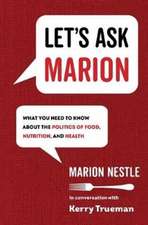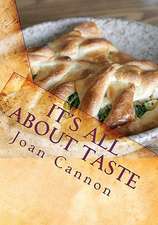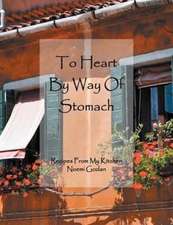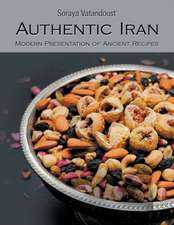The New Mediterranean Diet Cookbook: A Delicious Alternative for Lifelong Health
Autor Nancy Harmon Jenkins Marion Nestleen Limba Engleză Hardback – 30 noi 2008
"An irresistible invitation to share the healthiest diet in the world. It has one alluring recipe after another, each one fragrant with the fresh aromas of the ingredients I love the most: fish right out of the water, ripe vegetables from open-air markets, herbs from the garden. This book makes an overwhelming argument that the things that taste the best are good for you." -Alice Waters
Spanning the Mediterranean from Spain to France, Italy, and Greece, with side trips to Lebanon, Cyprus, and North Africa, this revised and updated edition of Nancy Harmon Jenkins's acclaimed cookbook offers ninety-two mouthwatering new dishes plus the latest information about the nutritional benefits of one of the world's healthiest cuisines. But best of all are the recipes-bursting with flavor, easy to prepare, and sure to please everyone at your table, whether you're cooking for yourself, your family, or your friends.
Known for classic favorites like tabbouleh and ratatouille, flatbreads, pastas, zesty herbs, and flavorful oils pressed from succulent olives, the Mediterranean diet combines delicious taste with health-supportive ingredients as few other cuisines do. With an emphasis on fruits and vegetables, grains and legumes, fish, lean meats, and heavenly desserts, here are recipes for over 250 outstanding dishes created for today's American kitchens. You'll also find new cooking techniques and a simplified approach to cooking-because simplicity is what the Mediterranean way of eating is all about.
Experienced and novice cooks alike will be inspired by these delectable, seasonally inspired recipes ranging from sweet young Roman-style peas for spring to skewered shrimp for summer, robust North African Pumpkin Soup when autumn is in the air, and warming winter dishes like Lebanese Garlicky Roast Chicken and Cypriote Braised Pork with Wine, Cinnamon, and Coriander-plus a variety of fabulous pizzas and dinner pies, hearty salads like Tuscan panzanella, and satisfying small dishes known as tapas. Also included is a special selection of traditional dishes prepared for Islamic, Jewish, and Christian holidays that can be enjoyed year round.
Rich in flavor and healthy nutrients but low in saturated fats and cholesterol, here are recipes that will delight your palate, nourish body and soul-and can be prepared with ease in your home kitchen.
Preț: 239.58 lei
Nou
Puncte Express: 359
Preț estimativ în valută:
45.84€ • 47.87$ • 37.86£
45.84€ • 47.87$ • 37.86£
Carte disponibilă
Livrare economică 25 martie-08 aprilie
Preluare comenzi: 021 569.72.76
Specificații
ISBN-13: 9780553385090
ISBN-10: 0553385097
Pagini: 496
Dimensiuni: 185 x 259 x 38 mm
Greutate: 1.08 kg
Editura: Bantam
ISBN-10: 0553385097
Pagini: 496
Dimensiuni: 185 x 259 x 38 mm
Greutate: 1.08 kg
Editura: Bantam
Notă biografică
Nancy Harmon Jenkins is a food writer with a passionate interest in Mediterranean cultures and cuisines, sustainable agriculture, and farm-to-market connections. Author of half a dozen highly acclaimed cookbooks, she writes for the New York Times, Saveur, and Food & Wine, and divides her time between her farmhouse outside of Cortona, Italy, and the coast of Maine.
Extras
Making the Change
Changing eating habits may seem like a radical and difficult chore, but changing to the Mediterranean diet is easy because most of the foods and cooking techniques are already familiar to us. It’s a shift of emphasis that’s the key to cooking and eating in a healthy Mediterranean style.
Except for olive oil, there’s no need for special foods in the larder—in fact, many of the foods featured in the Mediterranean kitchen are probably already in your pantry cupboard. Several different kinds of beans, both dried and canned, long-grain and short-grain rice, cornmeal for polenta and flour for bread, pasta in a variety of shapes, canned tomatoes, and condiments like dried mushrooms and herbs are common ingredients and take no special effort to acquire. If there’s an Italian, Greek, or Middle Eastern neighborhood nearby, you’ll have access to first-rate olives and cheese; otherwise, make a special trip some Saturday to a more distant market and spend time wandering around examining the offerings. If you’re far from ethnic shopping areas like these, mail-order and Internet suppliers are a good, if sometimes rather expensive, resource. (See pages 465–466 for some suggestions.)
We invent all sorts of rationales for holding back on changing diets, especially where families are involved. But there are compelling reasons for making the switch, and most of the obstacles are easily overcome. Just remember that where families are concerned, change sometimes has to come slowly. Whatever you do, don’t make a big deal out of it. Small, quiet, almost unnoticeable changes are more effective than noisy family food fights.
Start off by structuring mealtimes, if you don’t do that already. It’s hard for American families, with so many of us apart at lunch, but dinner at least should be a time for the family to come together and share whatever is on the table. Try to have meals on the table at the same hour each day and let people know they’re expected to be there. It’s the first step in a Mediterranean direction, building a sense of food as a fundamentally communal, shared experience.
Switch from whatever fats you now use to extra-virgin olive oil. If you find it hard to get used to the flavor of extra-virgin oil, start off by combining it 50/50 with canola oil, which has no perceptible flavor or aroma. Gradually reduce the amount of canola as you grow accustomed to the delicious flavor of olive oil. Experiment with oils by buying several different varieties in small quantities—the flavors vary enormously from country to country, region to region, and even producer to producer. Begin by throwing out all those bottles of commercial salad dressing that are crowding your refrigerator shelves. Then follow one of the recipes on pages 261–264 for tasty salad dressings using extra-virgin olive oil. Start using olive oil to sauté meat, chicken, or fish. More flavorful oils are wonderful for frying potatoes, especially with a little garlic or onion added—another way to accustom your family to the distinctive flavor. Soon you may find yourself using truly aromatic oils on steamed vegetables or baked potatoes in place of butter or sour cream. Then you’ll be ready for a real summertime treat—extra-virgin olive oil lavished on fresh seasonal corn.
(For more on olive oil, see pages 30–33.)
Get out of the butter habit. A little butter from time to time is fine, but butter is never on the Mediterranean table, never assumed to be an automatic accompaniment to bread. Even at breakfast, only a little jam garnishes the bread, which is appreciated for its own good flavor. (And contrary to American restaurant custom, bowls of olive oil, even of the finest extra-virgin, are never put on the table, except during the autumn harvest when the flavor of new oil is appreciated.)
Use more whole grains. Even though Mediterranean cooks seldom use whole-wheat pasta or brown rice, they still get plenty of whole grains through dishes like tabbouleh, the hearty Lebanese salad, and bulgur pilafs. And breads throughout the Mediterranean are often made with unrefined wheat and barley flours. Fortunately we have much greater access to really high-quality bread than we had 15 years ago when I compiled the first edition of this book, but if you can’t find the kind of bread you want nearby, try making it yourself. It really isn’t time consuming once you get the hang of it, and that’s quickly acquired. And presenting a homemade loaf of high-quality bread on the table is just eminently satisfying.
Begin or end each meal with a salad. Make it from crisp greens and whatever vegetables are in season—tomatoes, cucumbers, sweet peppers, scallions, shavings of carrot, sherds of fennel, celery, tender chicory, raw fava beans. Don’t use iceberg lettuce, which has almost no nutritional value, but do look for dark green leaf lettuces like oak leaf and romaine. Add some fresh green herbs for variety, but not all at once—basil at one meal, dill at another, cilantro, if you like it, at a third.
Add both more vegetables and different vegetables to the menu. Get away from the American focus on potatoes, peas, and salad greens. Nothing wrong with any of them but life is so much richer! The average American consumes just three servings of fruits and vegetables daily and many Americans don’t even get that. The latest Dietary Guidelines for Americans, published by the Department of Health and Human Services, recommend up to nine servings, which is about 41?2 cups, for otherwise healthy people consuming 2,000 calories a day. So let vegetables take up most of the room on your plate.
Every day try to get in at least one serving each of cruciferous (cabbage family) vegetables—broccoli, broccoli rabe, cabbage, cauliflower, turnip and mustard greens—and bright-colored vegetables and fruits that are rich in antioxidants—again broccoli and broccoli rabe, but also carrots, sweet potatoes, spinach, and yellow squash, as well as apricots and cantaloupe, just to mention a few. Experiment with different vegetables, ones that may not be familiar—artichokes, leeks, fava beans are exotic to many Americans, and vegetables like Jerusalem artichokes (sunchokes), celery root, and many greens are virtually unknown.
Vegetables don’t have to be served separately—vegetable combinations, vegetables cooked in a sauce for pasta, vegetables served cut up in a soup, are all ways to increase the quantity consumed. But no single fruit or vegetable provides all the nutrients you need to be healthy. In the end, it’s variety that is the key.
Cut down on the amount of meat consumed. There’s no reason for normal, healthy adults to eat more than 4 ounces of lean meat a day, and much less is much better. Children, of course, need even less. (If your family is used to 8-ounce portions, start cutting the portions down gradually rather than all at once.) Eat lean red meat (beef, pork, and lamb) just once or twice a week. Other meals can feature chicken, fish, pasta, rice, beans, or vegetables.
One easy way to cut meat consumption is with stews that feature meat as an incidental to lots and lots of vegetables. You’ll find recipes for such preparations throughout this book. Or make a hearty soup the main course, with plenty of bread, perhaps a little cheese, and salad to accompany it. Soup is a delicious and cheap way to get lots of vegetables on the table.
Move meat away from the center of the plate by adding complex carbohydrates like rice, beans, and pasta to fill the gap that meat once occupied. When you do serve a main course of meat or fish, get into the Mediterranean habit of offering a filling first course of pasta or soup before the meat arrives.
And if you’re worried about budgetary constraints, think of this: by adding olive oil and subtracting meat, you’ll probably come out even over the course of a week.
Think about portion size, especially when dining in restaurants. Americans on the whole now spend almost half their food dollars outside the home in fast-food, take-out, and family-style restaurants. It’s no secret that portion sizes have increased dramatically in such food outlets—indeed, some national chains actually brag about the humongous size of burgers, fries, and soft drinks, and what a bargain they are. Some bargain! Anyone who saw the movie Supersize Me knows all too well the consequences of this. But when Drs. Lisa Young and Marion Nestle at New York University studied the phenomenon, they discovered that between the 1975 and 1997 editions of the Joy of Cooking, that venerable cookbook has decreased the number of servings it says a given recipe will yield. No wonder we’re a fat nation, cradle to (often early) grave.
Now think of a deck of cards: that’s about the portion size of meat or fish in a restaurant in just about any country in the Mediterranean, and the vegetables, the soups, the pasta and rice dishes are equivalent. As for dessert, most often, if it’s anything at all, it’s a single small portion of seasonal fruit. If there’s an actual sweet involved, it will be the size of a little espresso cup, no more.
So think about portion size, whether at home, where it’s much easier to control, or when eating out, where it’s often quite difficult. In the right kind of restaurant, you can order from the appetizer list where portions are notably smaller. Or share a main course with a friend dining with you. Or eat half the presentation and ask to bag the rest to carry home.
Substitute wine in moderation for other alcoholic beverages. If you enjoy wine with your meals, you’re already well on the way to a Mediterranean lifestyle. Except among strict Moslems, wine is part of every Mediterranean meal but breakfast. The operative words here are part of the meal. In the Mediterranean, wine is a companion to food and almost never taken on its own. Even a glass of wine or an aperitif as a cocktail before dinner is always accompanied by something to eat—if not a full-fledged meze, then a few olives or a handful of almonds. Wine in moderation, a couple of glasses a day served with meals, seems in fact to be protective against coronary heart disease.
If you don’t care for wine, don’t turn to soft drinks or fruit juices, even natural ones, as they are all potent sources of sugar and/or calories. Drink water instead—a bottle or pitcher of water is a standard feature on Mediterranean tables. It doesn’t have to be expensive bottled water, either. Most of us in North America are fortunate to have access to good, clean water straight from the tap. Just don’t substitute milk, which comes into the Mediterranean diet after infancy only in the form of wonderful cheeses and yogurts or a little hot milk added to morning coffee. For normal healthy adults, enough calcium should be supplied by cheese, yogurt, and vegetables.
Don’t fuss with dessert. To me, dessert seems like useless and unprofitable time spent in the kitchen, and it’s certainly not necessary on the table. (Far better to spend that time making soup.) Above all, don’t buy packaged desserts, whether cakes, cookies, or ice cream—well, maybe ice cream as an occasional treat. Most packaged desserts are so loaded with saturated fat and sugar, not to mention stabilizers and other undesirable additives, that they are truly nutritional time bombs. All they really do is accustom the palate to sugary fats at the end of a meal. If you must have a sweet, the simplest of cookies is preferable to a rich cake; better yet is fresh or lightly poached fruit, which should be sweet enough in itself to satisfy any sugar addicts in the family. And with fruit you get valuable vitamins and fiber along with the sweet, something that cannot be said for other desserts.
Many restaurants will have a simple platter of fresh fruit or fruit with cheese on the dessert menu. Choose it instead of the sinfully chocolate drop-dead nightmare the pastry chef is so proud of. As more of us start asking for fruit, more fruit will be served.
Think about the quality of the food you buy and seek out the best. Because Mediterranean food is so simple, it’s worth spending time looking for the best ingredients. How do you go about doing this? Fortunately, it gets easier with each passing season. Start with the place where you customarily shop. Many supermarkets, responding to customer demand, have established sections devoted to organically raised produce and naturally raised meats.
If supermarkets have little to offer, look for farmers’ markets and health food stores that carry local, healthy ingredients. (Call the food editor of a local newspaper or your state university’s college of agriculture for information. Cooperative Extension agents can also be good information sources.)
Farmers’ markets are terrific sources. When you start to frequent them, you’ll also start to build up contacts with local farmers. They’ll not only tell you how the food is grown or produced; they may tell you how to cook it, too, and they’ll start to let you know what things are coming along. The best-run health food stores and co-ops are also good outlets for local production—fruits and vegetables, whole grains and beans, free-range chickens and their eggs, all of which will be fresher and more flavorful than most supermarket offerings. Many farmers’ markets and health food stores take WIC coupons and food stamps; if you’re on a tightly restricted budget, keep that in mind.
In restaurants, ask questions about where food comes from and let them know that you care. The best restaurants also care and work hard to advance quality.
In the end, it’s the simplicity of it all that makes the Mediterranean diet such an appealing alternative. Exotic foods, elaborate and time-consuming preparations, and special culinary techniques are not what it’s all about. Good food, carefully purchased, thoughtfully if simply prepared, and lovingly served and shared: that’s the secret.
Children and the Mediterranean Diet
Enjoyment is the key to supporting great nutrition, especially for young children, because if they don’t enjoy their food, they simply won’t eat it. But if you present food that is freshly prepared and tasty, even broccoli, children will almost always come around, especially if they see that everyone else at the table is enjoying the same thing.
All children seem to go through periods when they will eat only one thing—only white food, perhaps, or only peanut butter and jelly sandwiches (not a bad thing, as long as they’re made with whole-grain bread). The best course of action, we are assured by everyone from Dr. Spock on, is not to stress out, not to wring hands, not to indicate the least shred of anxiety—and above all, not to rush to offer an alternative. But almost all children love pasta and pizza, so start your Mediterranean diet campaign with one of those, prepared to be appetizing and full of flavor, presented as a family meal to be enjoyed all together—and you may find the battle is over before it’s even begun.
Changing eating habits may seem like a radical and difficult chore, but changing to the Mediterranean diet is easy because most of the foods and cooking techniques are already familiar to us. It’s a shift of emphasis that’s the key to cooking and eating in a healthy Mediterranean style.
Except for olive oil, there’s no need for special foods in the larder—in fact, many of the foods featured in the Mediterranean kitchen are probably already in your pantry cupboard. Several different kinds of beans, both dried and canned, long-grain and short-grain rice, cornmeal for polenta and flour for bread, pasta in a variety of shapes, canned tomatoes, and condiments like dried mushrooms and herbs are common ingredients and take no special effort to acquire. If there’s an Italian, Greek, or Middle Eastern neighborhood nearby, you’ll have access to first-rate olives and cheese; otherwise, make a special trip some Saturday to a more distant market and spend time wandering around examining the offerings. If you’re far from ethnic shopping areas like these, mail-order and Internet suppliers are a good, if sometimes rather expensive, resource. (See pages 465–466 for some suggestions.)
We invent all sorts of rationales for holding back on changing diets, especially where families are involved. But there are compelling reasons for making the switch, and most of the obstacles are easily overcome. Just remember that where families are concerned, change sometimes has to come slowly. Whatever you do, don’t make a big deal out of it. Small, quiet, almost unnoticeable changes are more effective than noisy family food fights.
Start off by structuring mealtimes, if you don’t do that already. It’s hard for American families, with so many of us apart at lunch, but dinner at least should be a time for the family to come together and share whatever is on the table. Try to have meals on the table at the same hour each day and let people know they’re expected to be there. It’s the first step in a Mediterranean direction, building a sense of food as a fundamentally communal, shared experience.
Switch from whatever fats you now use to extra-virgin olive oil. If you find it hard to get used to the flavor of extra-virgin oil, start off by combining it 50/50 with canola oil, which has no perceptible flavor or aroma. Gradually reduce the amount of canola as you grow accustomed to the delicious flavor of olive oil. Experiment with oils by buying several different varieties in small quantities—the flavors vary enormously from country to country, region to region, and even producer to producer. Begin by throwing out all those bottles of commercial salad dressing that are crowding your refrigerator shelves. Then follow one of the recipes on pages 261–264 for tasty salad dressings using extra-virgin olive oil. Start using olive oil to sauté meat, chicken, or fish. More flavorful oils are wonderful for frying potatoes, especially with a little garlic or onion added—another way to accustom your family to the distinctive flavor. Soon you may find yourself using truly aromatic oils on steamed vegetables or baked potatoes in place of butter or sour cream. Then you’ll be ready for a real summertime treat—extra-virgin olive oil lavished on fresh seasonal corn.
(For more on olive oil, see pages 30–33.)
Get out of the butter habit. A little butter from time to time is fine, but butter is never on the Mediterranean table, never assumed to be an automatic accompaniment to bread. Even at breakfast, only a little jam garnishes the bread, which is appreciated for its own good flavor. (And contrary to American restaurant custom, bowls of olive oil, even of the finest extra-virgin, are never put on the table, except during the autumn harvest when the flavor of new oil is appreciated.)
Use more whole grains. Even though Mediterranean cooks seldom use whole-wheat pasta or brown rice, they still get plenty of whole grains through dishes like tabbouleh, the hearty Lebanese salad, and bulgur pilafs. And breads throughout the Mediterranean are often made with unrefined wheat and barley flours. Fortunately we have much greater access to really high-quality bread than we had 15 years ago when I compiled the first edition of this book, but if you can’t find the kind of bread you want nearby, try making it yourself. It really isn’t time consuming once you get the hang of it, and that’s quickly acquired. And presenting a homemade loaf of high-quality bread on the table is just eminently satisfying.
Begin or end each meal with a salad. Make it from crisp greens and whatever vegetables are in season—tomatoes, cucumbers, sweet peppers, scallions, shavings of carrot, sherds of fennel, celery, tender chicory, raw fava beans. Don’t use iceberg lettuce, which has almost no nutritional value, but do look for dark green leaf lettuces like oak leaf and romaine. Add some fresh green herbs for variety, but not all at once—basil at one meal, dill at another, cilantro, if you like it, at a third.
Add both more vegetables and different vegetables to the menu. Get away from the American focus on potatoes, peas, and salad greens. Nothing wrong with any of them but life is so much richer! The average American consumes just three servings of fruits and vegetables daily and many Americans don’t even get that. The latest Dietary Guidelines for Americans, published by the Department of Health and Human Services, recommend up to nine servings, which is about 41?2 cups, for otherwise healthy people consuming 2,000 calories a day. So let vegetables take up most of the room on your plate.
Every day try to get in at least one serving each of cruciferous (cabbage family) vegetables—broccoli, broccoli rabe, cabbage, cauliflower, turnip and mustard greens—and bright-colored vegetables and fruits that are rich in antioxidants—again broccoli and broccoli rabe, but also carrots, sweet potatoes, spinach, and yellow squash, as well as apricots and cantaloupe, just to mention a few. Experiment with different vegetables, ones that may not be familiar—artichokes, leeks, fava beans are exotic to many Americans, and vegetables like Jerusalem artichokes (sunchokes), celery root, and many greens are virtually unknown.
Vegetables don’t have to be served separately—vegetable combinations, vegetables cooked in a sauce for pasta, vegetables served cut up in a soup, are all ways to increase the quantity consumed. But no single fruit or vegetable provides all the nutrients you need to be healthy. In the end, it’s variety that is the key.
Cut down on the amount of meat consumed. There’s no reason for normal, healthy adults to eat more than 4 ounces of lean meat a day, and much less is much better. Children, of course, need even less. (If your family is used to 8-ounce portions, start cutting the portions down gradually rather than all at once.) Eat lean red meat (beef, pork, and lamb) just once or twice a week. Other meals can feature chicken, fish, pasta, rice, beans, or vegetables.
One easy way to cut meat consumption is with stews that feature meat as an incidental to lots and lots of vegetables. You’ll find recipes for such preparations throughout this book. Or make a hearty soup the main course, with plenty of bread, perhaps a little cheese, and salad to accompany it. Soup is a delicious and cheap way to get lots of vegetables on the table.
Move meat away from the center of the plate by adding complex carbohydrates like rice, beans, and pasta to fill the gap that meat once occupied. When you do serve a main course of meat or fish, get into the Mediterranean habit of offering a filling first course of pasta or soup before the meat arrives.
And if you’re worried about budgetary constraints, think of this: by adding olive oil and subtracting meat, you’ll probably come out even over the course of a week.
Think about portion size, especially when dining in restaurants. Americans on the whole now spend almost half their food dollars outside the home in fast-food, take-out, and family-style restaurants. It’s no secret that portion sizes have increased dramatically in such food outlets—indeed, some national chains actually brag about the humongous size of burgers, fries, and soft drinks, and what a bargain they are. Some bargain! Anyone who saw the movie Supersize Me knows all too well the consequences of this. But when Drs. Lisa Young and Marion Nestle at New York University studied the phenomenon, they discovered that between the 1975 and 1997 editions of the Joy of Cooking, that venerable cookbook has decreased the number of servings it says a given recipe will yield. No wonder we’re a fat nation, cradle to (often early) grave.
Now think of a deck of cards: that’s about the portion size of meat or fish in a restaurant in just about any country in the Mediterranean, and the vegetables, the soups, the pasta and rice dishes are equivalent. As for dessert, most often, if it’s anything at all, it’s a single small portion of seasonal fruit. If there’s an actual sweet involved, it will be the size of a little espresso cup, no more.
So think about portion size, whether at home, where it’s much easier to control, or when eating out, where it’s often quite difficult. In the right kind of restaurant, you can order from the appetizer list where portions are notably smaller. Or share a main course with a friend dining with you. Or eat half the presentation and ask to bag the rest to carry home.
Substitute wine in moderation for other alcoholic beverages. If you enjoy wine with your meals, you’re already well on the way to a Mediterranean lifestyle. Except among strict Moslems, wine is part of every Mediterranean meal but breakfast. The operative words here are part of the meal. In the Mediterranean, wine is a companion to food and almost never taken on its own. Even a glass of wine or an aperitif as a cocktail before dinner is always accompanied by something to eat—if not a full-fledged meze, then a few olives or a handful of almonds. Wine in moderation, a couple of glasses a day served with meals, seems in fact to be protective against coronary heart disease.
If you don’t care for wine, don’t turn to soft drinks or fruit juices, even natural ones, as they are all potent sources of sugar and/or calories. Drink water instead—a bottle or pitcher of water is a standard feature on Mediterranean tables. It doesn’t have to be expensive bottled water, either. Most of us in North America are fortunate to have access to good, clean water straight from the tap. Just don’t substitute milk, which comes into the Mediterranean diet after infancy only in the form of wonderful cheeses and yogurts or a little hot milk added to morning coffee. For normal healthy adults, enough calcium should be supplied by cheese, yogurt, and vegetables.
Don’t fuss with dessert. To me, dessert seems like useless and unprofitable time spent in the kitchen, and it’s certainly not necessary on the table. (Far better to spend that time making soup.) Above all, don’t buy packaged desserts, whether cakes, cookies, or ice cream—well, maybe ice cream as an occasional treat. Most packaged desserts are so loaded with saturated fat and sugar, not to mention stabilizers and other undesirable additives, that they are truly nutritional time bombs. All they really do is accustom the palate to sugary fats at the end of a meal. If you must have a sweet, the simplest of cookies is preferable to a rich cake; better yet is fresh or lightly poached fruit, which should be sweet enough in itself to satisfy any sugar addicts in the family. And with fruit you get valuable vitamins and fiber along with the sweet, something that cannot be said for other desserts.
Many restaurants will have a simple platter of fresh fruit or fruit with cheese on the dessert menu. Choose it instead of the sinfully chocolate drop-dead nightmare the pastry chef is so proud of. As more of us start asking for fruit, more fruit will be served.
Think about the quality of the food you buy and seek out the best. Because Mediterranean food is so simple, it’s worth spending time looking for the best ingredients. How do you go about doing this? Fortunately, it gets easier with each passing season. Start with the place where you customarily shop. Many supermarkets, responding to customer demand, have established sections devoted to organically raised produce and naturally raised meats.
If supermarkets have little to offer, look for farmers’ markets and health food stores that carry local, healthy ingredients. (Call the food editor of a local newspaper or your state university’s college of agriculture for information. Cooperative Extension agents can also be good information sources.)
Farmers’ markets are terrific sources. When you start to frequent them, you’ll also start to build up contacts with local farmers. They’ll not only tell you how the food is grown or produced; they may tell you how to cook it, too, and they’ll start to let you know what things are coming along. The best-run health food stores and co-ops are also good outlets for local production—fruits and vegetables, whole grains and beans, free-range chickens and their eggs, all of which will be fresher and more flavorful than most supermarket offerings. Many farmers’ markets and health food stores take WIC coupons and food stamps; if you’re on a tightly restricted budget, keep that in mind.
In restaurants, ask questions about where food comes from and let them know that you care. The best restaurants also care and work hard to advance quality.
In the end, it’s the simplicity of it all that makes the Mediterranean diet such an appealing alternative. Exotic foods, elaborate and time-consuming preparations, and special culinary techniques are not what it’s all about. Good food, carefully purchased, thoughtfully if simply prepared, and lovingly served and shared: that’s the secret.
Children and the Mediterranean Diet
Enjoyment is the key to supporting great nutrition, especially for young children, because if they don’t enjoy their food, they simply won’t eat it. But if you present food that is freshly prepared and tasty, even broccoli, children will almost always come around, especially if they see that everyone else at the table is enjoying the same thing.
All children seem to go through periods when they will eat only one thing—only white food, perhaps, or only peanut butter and jelly sandwiches (not a bad thing, as long as they’re made with whole-grain bread). The best course of action, we are assured by everyone from Dr. Spock on, is not to stress out, not to wring hands, not to indicate the least shred of anxiety—and above all, not to rush to offer an alternative. But almost all children love pasta and pizza, so start your Mediterranean diet campaign with one of those, prepared to be appetizing and full of flavor, presented as a family meal to be enjoyed all together—and you may find the battle is over before it’s even begun.
Recenzii
“Nancy Harmon Jenkins is a marvelous writer, a fine reporter, and addicted to travel, people, history, and good food, which makes this book a joy. That it points to a healthful way to eat, incorporating the freshness and clear flavors of Mediterranean cooking, also makes it a daily delight.” —Barbara Kafka, author of Party Food
“Nancy Harmon Jenkins’s new book is an irresistible invitation to share the healthiest diet in the world. It has one alluring recipe after another, each one fragrant with the fresh aromas of the ingredients I love the most: fish right out of the water, ripe vegetables from open-air markets, herbs from the garden. This book makes an overwhelming argument that the things that taste the best are good for you.” —Alice Waters
“Although it’s technically a diet book, this book is so much more—a superbly written examination of Mediterranean food and life and one of the most exciting cookbooks of the year.” —Paula Wolfert, author of The Cooking of the Mediterranean
“A great body of scientific data indicates that a generous daily intake of vegetables and fruits, coupled with low consumption of meat and other animal products, is the basis of a healthy diet. In this book, Nancy Jenkins vividly demonstrates that giving up meat, potatoes, and gravy need not be a sacrifice but rather the beginning of a journey into a far more interesting and healthier world of eating.” —Walter Willett, Chairman, Department of Nutrition, Harvard School of Public Health
“An essential…. This revised edition of her bestselling title includes updated nutrition information, notes on sustainable agriculture and similar concerns, and more than 90 new recipes.”—Library Journal, starred review
“Nancy Harmon Jenkins’s new book is an irresistible invitation to share the healthiest diet in the world. It has one alluring recipe after another, each one fragrant with the fresh aromas of the ingredients I love the most: fish right out of the water, ripe vegetables from open-air markets, herbs from the garden. This book makes an overwhelming argument that the things that taste the best are good for you.” —Alice Waters
“Although it’s technically a diet book, this book is so much more—a superbly written examination of Mediterranean food and life and one of the most exciting cookbooks of the year.” —Paula Wolfert, author of The Cooking of the Mediterranean
“A great body of scientific data indicates that a generous daily intake of vegetables and fruits, coupled with low consumption of meat and other animal products, is the basis of a healthy diet. In this book, Nancy Jenkins vividly demonstrates that giving up meat, potatoes, and gravy need not be a sacrifice but rather the beginning of a journey into a far more interesting and healthier world of eating.” —Walter Willett, Chairman, Department of Nutrition, Harvard School of Public Health
“An essential…. This revised edition of her bestselling title includes updated nutrition information, notes on sustainable agriculture and similar concerns, and more than 90 new recipes.”—Library Journal, starred review
Descriere
One of the first books to promote the Mediterranean diet, Jenkins's work was a bestseller when it was published 15 years ago. Bursting with good health and great flavors, this updated edition features more than 250 recipes that highlight one of the healthiest diets in the world.























